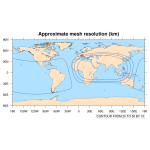The error in log.atmosphere.0000.err-3.txt is mostly likely not the cause of the segmentation fault that's occurring. That error occurs when a file that MPAS is going to write is present (perhaps from a previous run). By default, the model does not overwrite these files and produces this error. This error is not a critical error, and thus does not halt the model.
As the error log says, you can add `clobber_mode` to the history stream if you wish to overwrite any file that may be there from another run. See section
5.2 Optional stream attributes of the
MPAS Users Guide for more information and additional options for clobber_mode.
At this time I'm not exactly sure what is causing the segmentation fault that's occurring. Can you upload your log.atmosphere.0000.out and your streams.atmosphere file?
As well, I have noticed that for
config_block_decomp_file_prefix you have set:
x4.163842.graph.info.part. This is
not the 60 km quasi uniform grid, but the
92-25 km variable resolution mesh. Did you mean to use the 60 km mesh instead? (For reference, the 60 km quasi-uniform mesh filename is
x1.163842.grid.nc).
If you are running on the x4.163842.grid.nc by mistake, then your namelist values for config_dt and config_len_disp will be set incorrectly and could cause a segmentation fault as the model would probably become unstable if it ran with the 60 km values for those namelist options.
Do you want to ensure that you are using the correct mesh? The download page for MPAS meshes are here:
http://mpas-dev.github.io/atmosphere/atmosphere_meshes.html (in case you don't have it).

